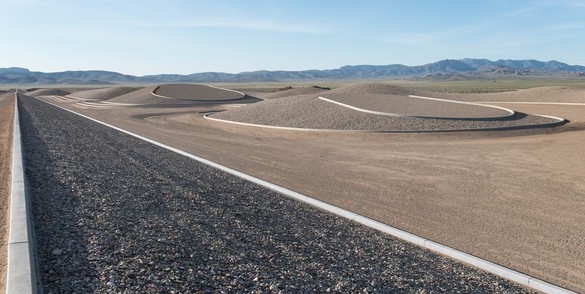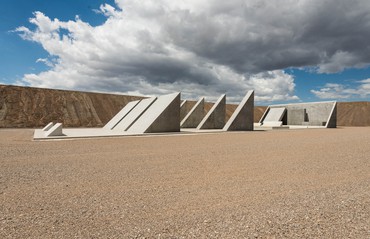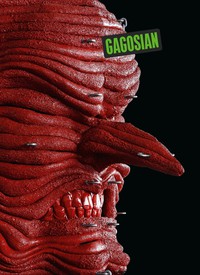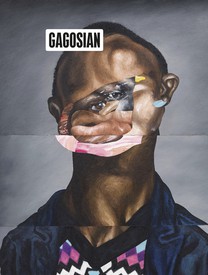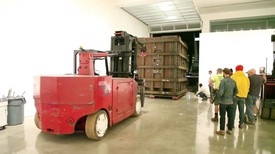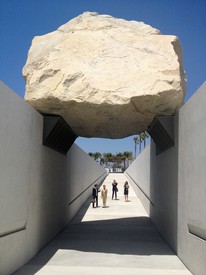In geological antiquity, about 360 million years ago, an asteroid slammed into the shallow sea near what is now Alamo, Nevada, not far from what is now Michael Heizer’s City. The crash of the asteroid and the consequent tsunami flipped the seabed, destroyed marine life, and massaged the undulating sea bottom in preparation for the tectonic ballet that would accompany the separation of the continents some two million years later. In a process that geologists call subduction, the western geological plate (that would soon be California) pushed eastward under the coastal plate, lifting slabs of seabed a thousand feet thick into the air, creating the Sierra Nevadas. Eighty million years later, volcanic activity would erupt near what is now the Hoover Dam, creating a terrain of ash burned into basalt rock, leaving a caldera whose new rock walls now provide a cradle for the dam. In the west, the Sierras blocked the high desert from the shoreline, creating a rain shadow that obstructs the moisture coming in from the Pacific. To the east, assorted chains of mountains rose toward the high plains.
Now this is 360 million years ago, of course, but even so, that’s a lot of calamity for a relatively compact piece of real estate where nothing much else was happening, and in the progress of this geological narrative, the rocks and mud—the detritus of all this rising and falling—tumbled into the inland gap between the Sierras and the rising plains. One deposit crashed upon the next, burying the water tables deeper and deeper—a further guarantee of aridity.
Today, at certain places and at certain times, all of these events are still visible. You look back into deep time as into a quiet abyss. What you cannot see is the die-off of the large fauna, the mammoth and the dire wolves, about 10,000 years ago. In any case, the creatures are gone, and today, we call this deep box of rocks Nevada, where the greater Mojave Desert blends into the Great Basin Desert. The surface of this expanse, seen from above, resembles the mark of a tiger claw ripping the desert from top to bottom.
There are small mountains and taller mountains that are smoothed off here and there, by wind and water, to resemble mesas. There are tilts, cliffs, canyons, and meadows. There are ridges winding among the mountains and washes running north and south. There is virtually no flora beyond desert shrubbery, and thus, from the ground, there is no visible sense of scale or distance. There is only big space—“cowboy Afghanistan,” we called it when I lived in Las Vegas—a dog whistle for crazy people with their hair on fire and their heads full of wild ideas.
Michael Heizer’s City is sited due north of Las Vegas and due east of San Francisco in a piece of territory that from the air looks like a bruise because of the iron oxide in the soil—a red-tan desert shading from sienna to red ocher depending on the angle and intensity of the light. Heizer’s City is a crisp mile-and-a-quarter rectangular cut into the desert. It is a fourth of a mile wide and thirty-four feet deep at its deepest. It is laid into the rising eastern slope of a ridge that faces a mountain. On the ridge’s west side, a wash plunges south. On its east side, the rectangle opens out into the surrounding desert.
The City has many attributes of a city, but it doesn’t really look like one. Approaching the cut on foot from the north or south, elements of a cityscape seem to be rising or falling from within the excavation, which cuts flat into the rising ridge like a thin scrap of aluminum tape. The territory around the excavation is natural but appears to be groomed, tailored, and graded like a golf course minus the grass. As one walks up to an overlook, Heizer’s cultural interventions open out the space. The roads and domes and pits within the excavation are elegantly curbed into long, quiet Sumerian curves. They restore our sense of distance and scale, so that the complexity of the City reveals itself as a gracious intervention in the desert.
The wholeness of the excavation subordinates the intricacy of Heizer’s interventions. The City is a single thing, and, in this aspect, the idea of characterizing the sculpture as an earthwork seems redundant. It is made of earth and rocks, of course, but it is only an earthwork in the sense that a Raphael is an oil painting. Otherwise, the City is composed and complete, a Minimalist sculpture that does what Minimalism does, enlivening the space above and around it. It does not, however, embrace the parochial concerns of urban Minimalism; it is full and sturdy rather than sleek and empty; its manufacture, once you move the machines away, is timeless, datable anywhere from the Nazca lines to yesterday morning. Whatever the implements, you would need only some friends and the time to make it—so you might say that the excavation is as old or as young as you might imagine it to be.
I will begin here with the poet Shelley, 200 years ago, speaking for Michael Heizer in the desert. In Julian and Maddalo, Shelley writes, “I love all waste/and solitary places; where we taste/the pleasure of believing what we see/is boundless, as we wish our souls to be.” Boundless, in space and time, is the real issue here, of course, since Heizer loves big and the inference of boundlessness. He replaces artistic scale with architectural size, and, in many instances, he is ready to let big trump beautiful when big provides a better bang, although the loveliness usually survives just beyond our expectations.
Even so, it is best to start with Heizer’s “waste and solitary” place, Lincoln County, on the southeast edge of Nevada, where the City resides and to which Heizer’s earlier Double Negative (1969) stands nearly adjacent. Lincoln County is a harsh mistress. It is a desert expanse almost twice the size of Connecticut with a population the size of an apartment complex in New Haven—about 5,000 souls. There are schoolmarms and state employees in residence. There are juvenile offenders in the state facility in Caliente (population 888). There are ranchers who run a few cattle, and seniors who sip coffee in retirement centers. The younger folks ride motorcycles, pump diesel, and serve burgers to the endless stream of truckers who barrel up Highway 83, a twisty two-lane route through mountains and desert that is the quickest route from Los Angeles to Idaho. Fortunately the traffic runs mostly north, since truckers find more amenable routes back to LA.
The county includes Pioche (population 1,354), a mining town 6,000 feet up the Pioche Hills that was once the richest and roughest town in America—the site of the Boot Hill cemetery that had seventy-two residents before anyone died of natural causes. It includes the Extraterrestrial Highway, which runs from Alamo to Tonopah, passing through Rachel (population 54) where one can commune with American and German aliens at the Al-e-Inn—where you can talk about Area 51, which is just up the road. So, if you are looking for the cause of Heizer’s gaunt countenance and polyneuropathy, Lincoln County would be the place to start.
Heizer, of course, wears these afflictions as a pirate wears his wooden leg, and this makes it hard to place him anywhere but in the desert. We are talking about a resolutely intellectual and abstract artist who finds himself performing in a paperback romance and rather loving it. So, obviously, Heizer is an American, and always a proud autodidact, allergic to school. Like his fellow self-educator Robert Irwin, Heizer softens academic distinctions between the genres and eras of art, between archaeology and architecture, metaphysics and kinesthetics. Where you see a distinction, Heizer may not, so you are forced to distinguish between what you see and the preconceptions you brought with you into the desert.
There is a scene that writers seize upon in their essays about Heizer. In these essays, it is late evening and the generator has been shut down at Heizer’s Sleep Late Ranch. The artist and a couple of his friends are gathered around his dining table drinking espresso and whiskey by lamplight. The scene is nothing so banal as contemporary America; it is something out of Frederic Remington—out of Ernest Hemingway, Jack Kerouac, H. Rider Haggard, and Edgar Rice Burroughs. It calls up the big American dream of mortal men set against the mighty darkness of the continent. Writers use this trope to talk about how Heizer looks today and how he feels. We love it. We are smiling faintly at his ebullient megalomania, his belief that, a world away from us, he is making the newest, biggest, strongest, and most long-lasting work of art being made anywhere. We are bemused because we believe him, because we stand in awe at the fifty years of sweat and visual imagination that are embodied in the mounds and ditches of the City. The problem with this romantic vision, though, is that Heizer’s brazen aspiration tends to disguise the effortless grace and appropriateness of his formal accomplishments. Beautiful and big are uneasy companions but they coexist happily in the City at the Sleep Late Ranch.
Heizer, however, also belongs to the art world; he is neither more nor less crazy than the coterie of artists who began abandoning New York in the early 1970s with the rise of public virtue, public largesse, academia, identity politics, and European aspiration. I call these artists the Children of the Diaspora and regard them as Mandarin Modernists (Ellsworth Kelly) and Kinesthesiologists (Robert Smithson). So, as Heizer was gradually evacuating New York for Nevada, John Chamberlain, Jim Rosenquist, and Robert Rauschenberg were headed for Florida; Kelly was moving to Spencertown, Robert Indiana to Maine; Peter Saul and Donald Judd were making their way to Texas; Agnes Martin, Bruce Nauman, and Lynda Benglis were moving to New Mexico; Irwin, Ed Ruscha, and Peter Alexander were deciding to stay in Southern California. So, today, those of this diaspora who survive are scattered around the landscape of America like exotic flowers.
Heizer is one of their kin, I would suggest, and maybe the last of them. All of their work is premised on the precritical bang that commands our attention as a prelude to our interpretation. They all presume that there is an experience that is precedent to our little brains churning away for footnotes, that there is, initially, a bright moment—like a sudden cold rainstorm or a bear in the garbage. This idea of art having a precedent visual appeal, however, has all but disappeared among these artists’ younger siblings, who presume that we are required to think and need no invitation.
As you stand on the edge of the City and look down into its long extent, you see an easy deployment of mounds, pits, and other features that speak to half a century of accumulated labor and formal decisions, so there is no “reading” of the work. Things have changed in half a century, and the changes have changed. There is only a catalogue of ambition and a multiplicity of subsites that have grown in time and refinement with Heizer’s maturity. Heizer identifies about forty of these local events in his notes, but these are only guideposts in the construction and not part of the finished product. There are no words for us in situ because Heizer is serving up the mystery of things-seen, not the mystery of words-read. Each of the City’s features is bounded and set apart by curbs so the whole expanse feels like a dictionary glyph, like an instance of the “desert annotated,” or, since most of the mounds are surfaced with rocks and gravel deployed in specific shades and sizes, they are akin to a giant image laid flat.
There is no real way or available inference to determine how the City adapts to the existing terrain. All of the work’s compartments are nuanced into nominal, abstract configurations invisible from the ground. Each enclosure is a specified object unto itself, so it is easy to imagine the excavation floating just an inch or so above the actual desert that it represents, like a city or a map of itself—like the map in Jorge Luis Borges’s story that is as big as the kingdom it represents. So, in place of a fixed reading, there is an ambient inference of narrative and incident, a history of belief in the shifting categories of meaning, like a temple site in Mesoamerica or pueblo complexes up at Chaco Canyon.
One gains access to the City through a golf-cart-sized road that enters on the high edge of the cut. It divides into two roads that wind around the excavation before reuniting and exiting at the low, eastern edge of the work. One drives these paths at one’s leisure, and the effect is like a stroll through a nineteenth-century romantic garden, minus the flora. (The Bellingrath Gardens near Mobile, Alabama, is the best American example of such a garden, and the drawing of its footprint—the flowerbeds, ponds, and berms—is analogous to the arrangement of the City.)
So the footprint of the City is a glyph that we move through as through a hard garden. Things are gathered like to like—stones, gravel, shrubs, and earth, not flowers, not trees. There are vistas, disappearing lakes (with no water), disappearing roadways, and sudden reveals. There are plazas and courtyards. There are several idiosyncratic, autonomous sculptures that stand free: Complex One, Complex Two, and 45°, 90°, 180° are the landmarks. There are figures in Complex Two that grow out of an interior wall or seem to be laid upon it. Here and there these ornaments rise above their enclosure, running up from the ground. There is a cone rising from ground level and an inverted cone sinking into the earth beside it. By extension, as a garden in the desert, the City calls up all the Islamic paradise gardens that grace deserts around the world in these latitudes; the fields of gravel in the City echo fields of tulips in Istanbul. Most locally, the City is the first garden in Garden Valley, Nevada.
Amid all these mounds and reversed pits, it seems possible that the entire construction might be inverted—bottom for top, top for bottom—such that the mounds would become pits and vice versa. Like Double Negative, the City hints at a reverse of itself, and this, I think, might be the trick of it. The great critic Kenneth Burke had an idea that touches on the hard concept. In Burke’s reading, the identifying mark of human animals is their invention of the negative, in building and language. Without the negative there is no tense and no time, no narrative and no closure, no image and no imagination. It was from this assumption that Heizer developed his idea of “sculpture in reverse,” which takes us back to the original concept of the City and its genesis in the last stages of Heizer’s first major work of art, Double Negative. Double Negative is the classic demonstration of negativity empowered. It is configured as two sloping rectangular cuts facing one another across a blind canyon. The cuts match one to one; they infer a rectangular, invisible beam crossing from one cut to the other, so that the space between them is at once negative for the open space between the walls of the canyon and twice negative for the imaginary beam inferred from cut to cut—a doubled negative that represents a positive, thus the title.
The formal problem that Double Negative addresses is simple enough in the realm of outdoor sculpture. If the vertical height of a sculpture is less than half its circumference with the base as center, the piece is harmonious with the earth. If the vertical height of the piece is more than twice the circumference, it disassociates itself from the earth and loses reference against the sky, so there had better be some sort of figure on top. The problem is a version of the Goldilocks theorem, a proposition grounded in the distance between Venus and Mars. Astronomers call this space the “habitable zone.” Life is possible on Venus, Earth, and Mars, but Venus is too hot for earthly species and atmospherically hostile, Mars is too cold and too arid, while Earth is “just right”—thus Goldilocks.
To put it simply, artworks in Heizer’s canon may be air or object, and in the crying emptiness of the Great Basin Desert, the idea of extending the earth upward—of lifting artworks as vertical objects that retain their presence—is feckless, mainly due to the desert’s lack of scale. It is better to extend the sky into the adjacent earth because the sky wins. The sky always wins. So it is best to extend the sky, as Albert Bierstadt did at Yosemite, and make a “sculpture in reverse.” The distances and balances of the City echo these relationships but differ in two main qualities. First, unlike Double Negative, there is no sense of intellectual demonstration in the City—no QED. Second, there is no waste. Everything that has come out of the excavation of the City has been carted away or integrated back into it, to reappear in another form, altered by arrangement and compression. Most important, the City has a unitary armature. It is one thing. Natives like myself would call it “the place where the desert is set into the desert and seems to hover above it.”
So, when we ask what makes the City a city rather than a town or a garden, we must consider the autonomous sculptures that are integrated into the field of domes and pits and roads. They are landmarks, the features of orientation that make the City a specific city, as the Empire State Building, the Metropolitan Museum, and Times Square make New York New York. The sculpture installation 45°, 90°, 180° serves as the capstone to Heizer’s project. It sits at the higher, western end of the terrain. It is the first thing we see and the last major object created for the City. It is a field of white reinforced-concrete objects dominated by enormous forty-five-degree triangles twenty-seven feet high. These triangular monoliths, in various thicknesses and alignments, are deployed upon a large, white, rectangular palette. Two of them rest on the south end of a large concrete shelf facing east toward another rank of triangles resting on the palette. One infers from this, by kinesthetic logic, that all of these pieces derive from a prior conceptual, rectangular object, which we might reassemble in our minds, since forty-five-degree triangles assemble into rectangles. The unity of the dispersed units, then, is held together by our instinctive effort to reimagine the pieces drawn back together into some original state. This, needless to say, is a very sophisticated formal solution, and it lends the whole complex a corporate grandeur to which corporate art could never aspire.
Complex Two is an exercise in ornament. A section of interior wall, about 500 feet in length (neither too short nor too long), is adorned with stelae that ascend from the ground and extend above the top of the wall. Other shapes are laid in relief upon the wall, creating a decidedly Assyrian prospect, an instance of vertical lift in an otherwise horizontal realm. Most interestingly, from certain angles the placement of these ornamental walls creates a backdrop for Complex One, the omphalos or navel of the whole project, which was built first, on level ground, at the bottom of what would become the long, flat excavation of the City. These two sculptures combine to create the most resonant evocation of ancient practice in Heizer’s domain. There are echoes of the pyramid of Djoser at Saqqara, Egypt, with its rounded corners, and of the Mayan buildings at Chichén Itzá on the Yucatan Peninsula. So we stand there, face to face with the abyss of geological time, and, standing there, we sense a compression of human time. The heyday of Egypt and the Yucatan don’t seem so very long ago at all.
Complex One is among the most present and simultaneously alien sculptures I have seen, and like a lot of great projects, it is based on an incredibly rudimentary idea—the idea that things may seem irrational at close range and meaningful at a distance, which is the idea of most architecture and all of Impressionism. The sculpture is composed of five elements that seem at first glance to be whimsical and a little goofy, something in the realm of alien architecture, modern British sculpture, and other things that are very big. The main island of Complex One is twenty-four feet high, a humbling elevation for six-foot creatures like myself, especially since the island’s length is nearly twenty times mine, at about 120 feet.
I ask myself this question: how did I know that this piece, somehow, in some conception, makes sense? I’m not sure, but I attribute this crypto-certainty to the anomaly of intentionality in contemporary art—the mysterious fact that we can recognize that a work is “on purpose” long before we have any notion of what that purpose or intention might be, if we ever do. (I still worry about the “intentions” of the Ellsworth Kellys in my living room.)
So we must narrow in on the work itself. The main element of Complex One—the 120-feet-long, 24-feet-high trapezium of dirt—has a long rectangular front that tilts forty-five degrees inward, such that the the two vertical slabs of concrete that form the sides of the piece take the shape of triangles cropped flat at their tops. A white concrete bar rests on the top right side of the long tailored island. On its right edge, a concrete bar extends downward at forty-five degrees with the angle of the dirt, trimming that side of the mound. On the near left side of the trapezium, a T-shaped concrete bar extends forward from the top of the mound, so that the cross bar of the T is parallel with the base of the island.
The front of Complex One is defined by three outriders of white reinforced concrete. On the left front of the trapezium a rectangular bar at the foot of the mound extends nearly halfway down its length. About twenty feet farther out from the mound is another bar that extends from the center of the trapezium to its right end. At the left end of the trapezium an inverted L shape rises from the ground to a little higher than the top of the main element. It faces to the front.
At first glance, there is a kind of teenage zaniness to the Complex One piece, although its sheer size argues against it and, to be honest, I liked the craziness so much that I didn’t really think about its conceptual resolution until someone explained to me that, if you step back from the sculpture about the length of two football fields, all the concrete addenda combine to frame the field of dirt in white concrete, transforming it into a sort of painting, like an early Robert Rauschenberg, maybe. My friends showed me a picture of the piece from the appropriate distance and voilà, there it was, very fun and very funny, especially when you consider the amount of plotting, labor, and trigonometry that went into this cool illusion. There is a passion to it, like those elegant hot rods we drew in high school. As I write this, I realize that many of my colleagues might think this humorous diminution is somehow disrespectful of Heizer’s practice. I don’t think so. Heizer is not respectable. He is a live spirit in the world, absolutely empowered, and any effort to tone him down, to theorize him and fit him into a lockstep art-historical and political narrative, rather defeats the privilege of his hard-won freedom. Such intellectual pretension promises to banish Heizer to the airless box in which Smithson’s reputation currently resides, into which, I have to hope, Heizer would rather not go. So I prefer to remain the beneficiary of the artist’s generosity and high-hearted cleverness. How kind, I thought, of Michael Heizer to have made this city for me, to have set it afloat in the wilderness, in the deep tides of geological time. May it last forever, I thought, looking down on it, or at least until the supervolcano under Yellowstone Park conspires with the San Andreas Fault to create a cataclysm compared to which that original asteroid slamming down out by Alamo is little more than a pebble cast into a stream.
